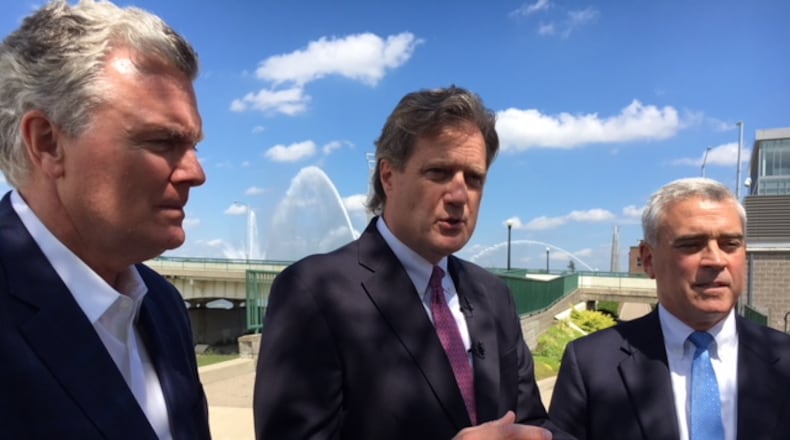“There’s nothing we can really publicize yet, but we’re working hard,” he added.
Simms moved into one of his own developments, Monument Walk, from Washington Twp. about three months ago, making him one of downtown’s 2,000 residents.
GALLERY: Check out the new Huffy HQ
In six years, Simms has been the driver behind six downtown Dayton projects, most recently City View, at Fourth and Patterson streets near the re-built downtown library. Charles Simms Developments has built almost 105 townhomes downtown, with about 100 sold.
Fueling these kinds of projects and are tax credits and federal grants, Simms said in a joint press conference with U.S. reps. Mike Turner (R-Dayton) and Brad Wenstrup (R-Cincinnati) who is a member of the House Ways and Means Committee, Congress’s chief tax-writing committee.
Even though Simms said he has not employed federal credits for his non-historical, new construction projects, he hailed what he called “private and public partnerships.”
MORE: Dayton History is planning a big announcement
“We need them for the overall picture,” Simms said. “Water Street and other residential developments would have not come into place without those tax credits. Developers use them for capital. They use them for infrastructure costs.”
Credits can also go to downtown residents who can relieved of property taxes for a set period, such as 10 to 15 years.
Said Simms, “It’s not just for the developers.”
Wenstrup said credits and other tools have helped revitalize the Over The Rhine neighborhood in Cincinnati.
MORE: Meijer partners with Starbucks on the gas station of the future
“We’re seeing the public-private partnerships are enhancing a lot of our areas,” Wenstrup said. “It is driving opportunities, driving the increase in jobs.”
Simms said he was confident that “jobs will follow” residents, slowly filling downtown office buildings have suffer from relatively high vacancy rates.
Downtown Dayton office space was 26 percent vacant as of the first quarter of this year, more than double the 10.3 percent national average, Colliers International said earlier this month. Only six other downtown office markets studied by the real estate firm had vacancies above 20 percent.
Turner said the credits, grants and opportunity zones, make possible projects such as Fifth Third Field, the Schuster Center and even the RiverScape pavilion where he spoke, which is located where a Sears auto center once stood, decades ago.
The RiverScape site took millions in environmental remediation, Turner said. CareSource offices just across from RiverScape are on land that was once near a coal gas plant, also requiring remediation, he said.
“A community can’t do it all on its own,” said Turner, who served as Dayton mayor from 1994 to 2002. “The city of Dayton could not just dip within its coffers and do the environmental remediation. We needed to be able to turn to the federal level.”
Turner is running for re-election. His Democratic opponent is Theresa Gasper. A message seeking comment was sent to a Gasper campaign representative.
About the Author

